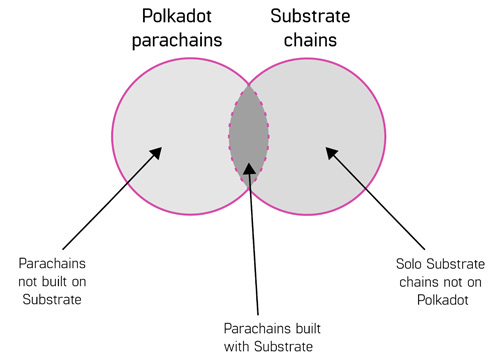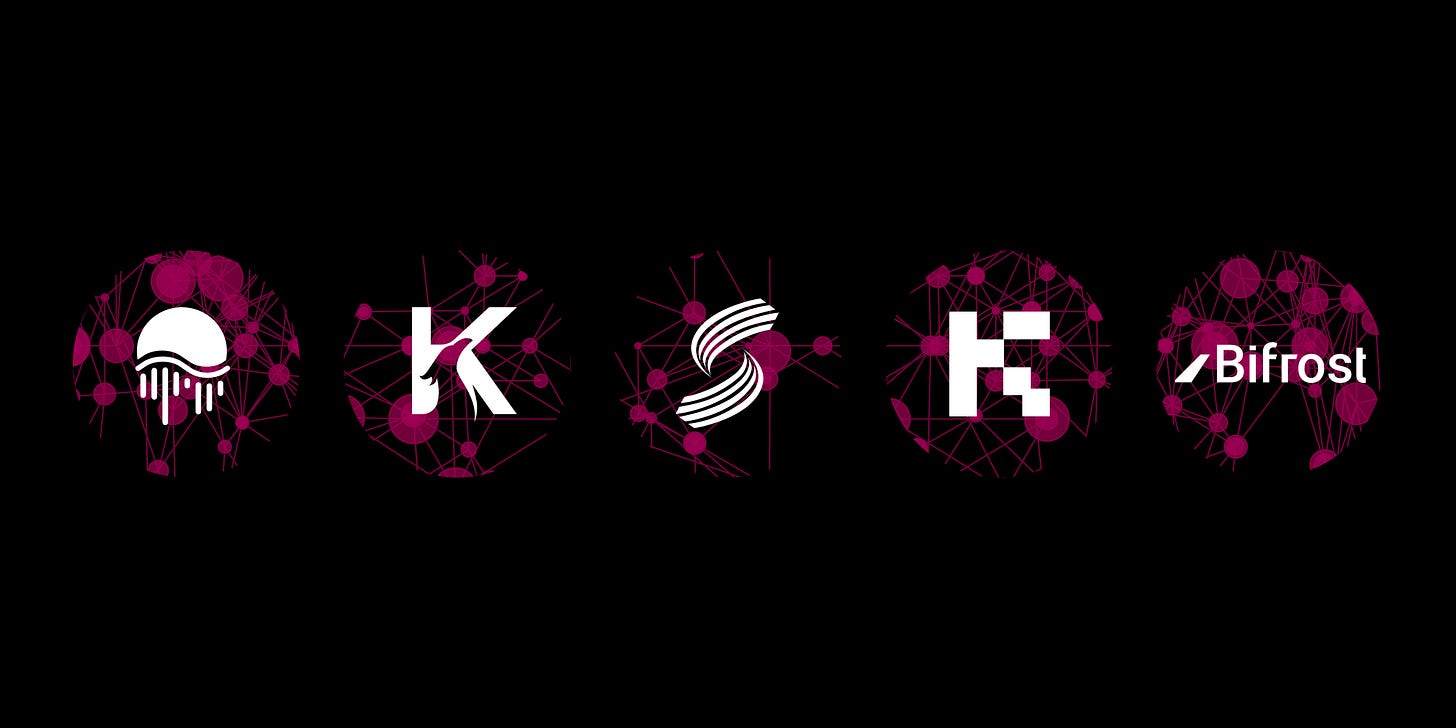Dot Pulse #4 — Insta-Win Crowdloans and New Launches
Learn about Substrate, Parachain progress, who’s winning the auctions, stories of the week and governance watcher! 📣
Welcome to Dot Pulse, your window into the Polkadot DeFi ecosystem.
If you’re a humble farmer looking to learn more about Polkadot’s DeFi opportunities, or even if you’re a seasoned DOT/KSM staker, this newsletter is the place to find all the latest events in Dot land.
Subscribe now to receive regular updates about Polkadot development, crowdloans and parachain auctions, new exciting DeFi projects, and anything else worth knowing about Polkadot.
This week we will focus on a piece of Polkadot technology that isn’t necessarily related to it, but it’s a key element of Polkadot’s vision nonetheless: Substrate.
Substrate is the blockchain SDK built by Parity that is used to program the nodes of the parachains and the relay chain (and subsequently, the blockchain itself).
If you’ve ever played video games, you’d probably have heard of game engines like Unity, Unreal Engine or countless others — Substrate is like those, but for blockchains. Like with game engines, you can build a variety of different blockchains for different applications that will still share the same feel and underlying scaffolding.
What’s really important about Substrate is that it’s flexible. The SDK can be used to create your own parachain, parathread, or even an entirely stand-alone blockchain. You can create a blockchain that just changes a few parameters, or it could implement some custom “pallets” (basically, program modules) for more advanced functionality. You can even uproot the entire logic and create something almost entirely custom-built.
Most of the time, you’ll just be using Substrate to design your parachains and connect them to the Polkadot network. There are a few stand-alone Substrate blockchains right now, but the majority of them plan to eventually integrate with Polkadot anyway. What’s funny is that you don’t even need to build on Substrate to become a parachain. If you implement all of the required interfaces and logic to connect to the network, you can make your own parachain from scratch. Not that it would make much sense to do so...
Cool features of Substrate
We wouldn’t be writing about this technology if it didn’t enable at least a few awesome things!
As the blockchain layer of Polkadot’s parachains, Substrate’s features directly influence how DeFi will work on Polkadot.
Substrate’s runtime modules mean that you can implement DeFi protocols at a parachain level, exactly as if they were native functions of the blockchain. Runtime modules are also upgradeable without hard forks. This is quite useful for a lot of parachain projects that want to create their own advanced protocols.
Substrate’s customizability is based on Pallets, which are blockchain modules that execute certain general tasks. You can simply include a pallet in your parachain and have an easy-to-use implementation of some basic feature. Pallets come in a variety of forms and features: there are pallets to do governance and voting, social recovery, consensus, contracts (both standard and EVM), randomness, proxy transactions and many more.
But beyond the pallets, Substrate integrates some very useful mechanisms to better serve DeFi protocols. For example, you can schedule transactions through the Scheduler pallet, which means that in many cases Polkadot doesn’t need special “agents” or “keepers”. On Ethereum, external keepers are necessary to “manually” send transactions to perform some tasks (for example, auto-compound vaults on Yearn Finance).
Another useful feature is the Off-chain Worker, which is like an integrated oracle always at the contracts’ disposal. You can send HTTP requests (executed by the validators directly), perform complex computations and do all sorts of things that don’t require on-chain presence. Of course, the Oracle Problem still applies, so this data will need to be validated somehow.
The auction for Kusama slot 6 has barely begun but we already have a likely winner! KILT protocol collected its cap of 220,000 KSM (almost $90M). KILT is a decentralized identity protocol offering anonymous and revocable credentials. Though it focuses more on enterprise, anonymous identities could work great with DeFi to enable democratic governance, better rewards systems or even some form of decentralized KYC.
The DeFi-centric front-runners are Calamari and Basilisk with 112,000 and 49,000 KSM, respectively. It’s unlikely they’ll be able to reach KILT for this slot, but the next auctions will definitely be much more competitive!
Active Crowdloans
TL;DR: Manta Network’s Kusama parachain (zkSNARK-based private token transfers and a private DEX) distributes a maximum of 30% of supply (which is quite generous!) with a 10% early bird bonus and referrals.
TL;DR: HydraDX’s Kusama chain (cross-chain DEX parachain) will grant you some HydraDX tokens for supporting the Snek. Also the earlier you get in the more tokens you receive.
TL;DR: Centrifuge’s Kusama chain (brings real world assets to DeFi) combines crowdloan rewards with a 1:1 CFG snapshot for existing holders. Sitting at a comfy 36k KSM for now.
TL;DR: Parallel Finance on Kusama (leveraged staking, lending) distributes up to 5% of max supply in the crowdloan. Collected 33.5k KSM so far.
Active Farms
Earn KAR by staking into the KSM/kUSD and KAR/KSM pools on Karura DEX
Yields are now get 64% APR (or 90% with loyalty bonus) for KSM/kUSD farming, or 18% (37% with loyalty) for KAR/KSM.
The Polkadot team released a “state of the parachains” overview where they interviewed each existing parachain team to learn where they’re at in terms of deployment.
Karura and Moonriver are currently the furthest ahead in terms of enabling the features they promised.
Karura, after launching its kUSD generation platform and the Karura DEX, is now working to deploy KSM liquid staking and its EVM.
Moonriver enabled the EVM last week, allowing projects currently on the Moonbase testnet to begin deploying their contracts. No real updates on that front for now, so stay tuned for new farms!
The other live parachains (Bifrost, Shiden and Khala) are still at various stages of initializing their platforms.
Bifrost is currently working on Sudo removal (admin privilege) and will start enabling vsKSM transfers, swaps and bridges. The project focuses heavily on staking derivatives and enabling higher capital efficiency for other parachain bids through SALP.
Shiden expects a full launch with the EVM by the end of September. So far they’ve activated PoS on the network, though they still need to add delegation mechanics.
Khala expects to enable TEE mining and transfers by the end of September, and after that they’ll focus on cross-chain features. Khala is able to onboard privacy-oriented DeFi projects, though their secrecy relies on the validators’ hardware and not verifiable cryptography.
All of the projects are looking to use Kusama’s full potential with cross-parachain interoperability, though a few of them are still in the testing stage.
Karura is already accepting token transfers with KSM, and it conducted a test for sending raw code to the Kusama relay chain.
Moonriver plans to enable a bi-directional bridge with Karura soon, and it’s also working on Ethereum/EVM bridges with several partners.
Khala has launched a bridge to Ethereum for KHA
Shiden has previously connected with Acala in the Rococo testnet
Bifrost is working on bridges to Statemine and Karura
The full awakening of the Polkadot ecosystem is still going strong, so stay tuned for the next edition!
TL;DR: Bifrost aims to support Calamari, Altair and Basilisk by enabling KSM liquid derivatives for the assets locked in the crowdloan contracts.
TL;DR: The SDN tokens are now transferable, so Shiden is effectively launched now.
TL;DR: Moonbeam has finalized the list of people who will receive GLMR tokens in the third round.
TL;DR: The team distributed the first 30% of tokens reserved for crowdloans, with the remainder being vested over time.
(Polkadot) Referendum 33, enabling runtime v9090 (enabled on Kusama last week). Likely to pass.
(Polkadot) Motion 107, approval requested for funding Polkadot Ecology Research Institute
(Kusama) Referendum 131, executed to fix an oversight where crowdloan participants who failed couldn’t retrieve their KSM.
All info in this newsletter is purely educational and should only be used to inform your own research. We're not offering investment advice, endorsement of any project or approach, or promise of any outcome. This is prepared using public information and couldn't possibly account for anyone's specific goals or financial situation. Be careful and keep up the honest work!










